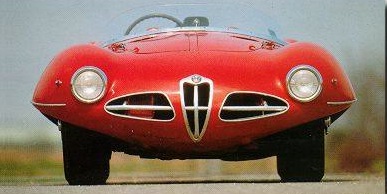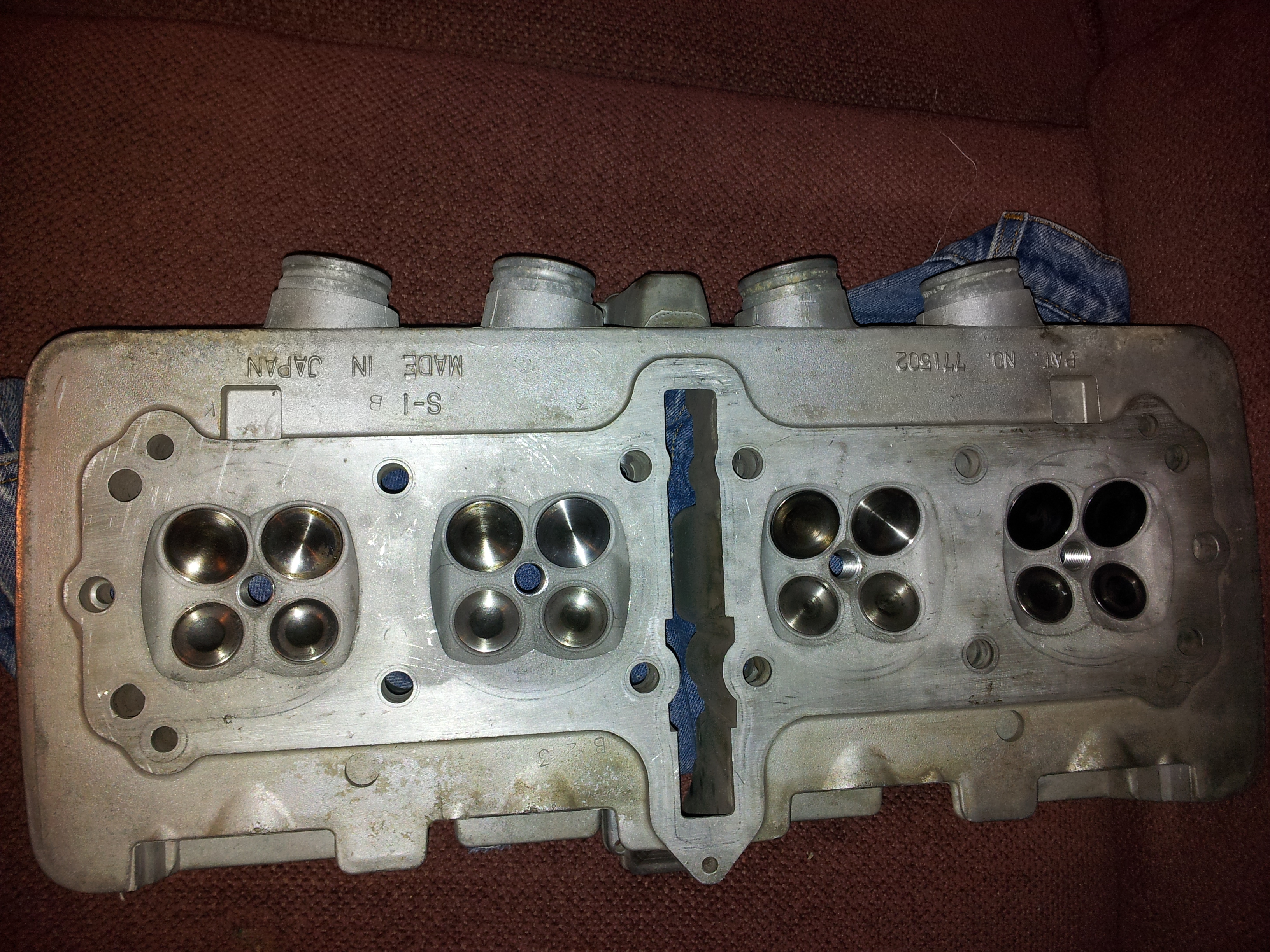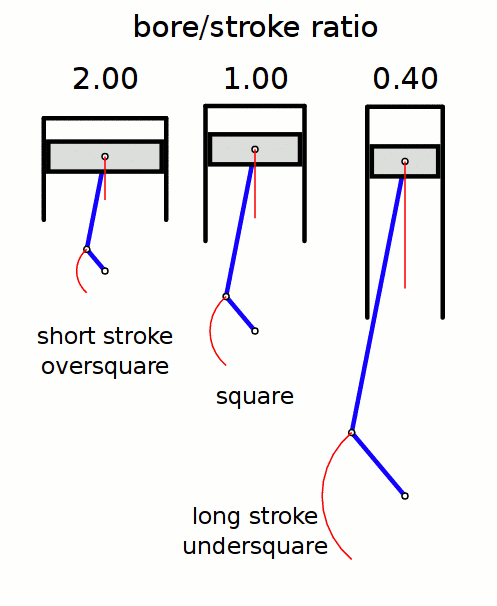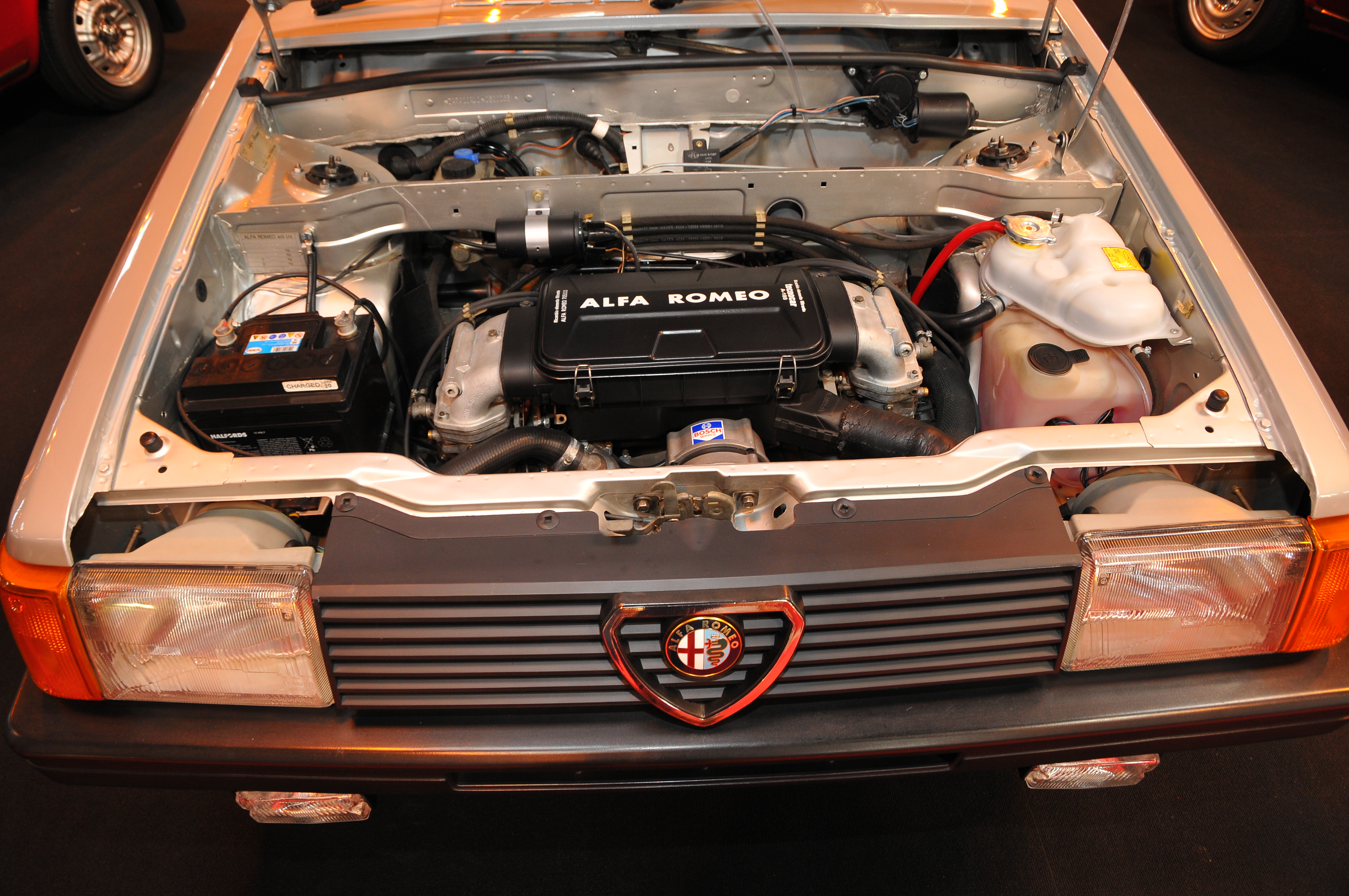|
Alfa Romeo Twin Cam Engine
The Alfa Romeo Twin Cam engine is an all-alloy inline-four engine series produced by Alfa Romeo from 1954 to 1994. In Italian it is known as the "bialbero" ("twin-shaft"), and has also been nicknamed the "Nord" (North) engine in reference to its being built in Arese, close to Milan, in the North of Italy and to distinguish it from the Alfa Romeo Boxer engine built in the South (Sud) for the Alfasud. History The Twin Cam's predecessor appeared in the 1950 Alfa Romeo 1900 and was an under-square inline four cylinder with a cast-iron block, an aluminium alloy crossflow cylinder head with double overhead cams and a 90° included angle between intake and exhaust valves. Development of that engine was overseen by Orazio Satta Puliga who would also helm development of its successor. The 1952 Disco Volante had a 2-litre DOHC four cylinder engine with an aluminium block and sleeves, but this seems to have been a custom version of the 1900 engine rather than a prototype of the forthcom ... [...More Info...] [...Related Items...] OR: [Wikipedia] [Google] [Baidu] |
Alfa Romeo
Alfa Romeo Automobiles S.p.A. () is an Italian luxury car manufacturer and a subsidiary of Stellantis. The company was founded on 24 June 1910, in Milan, Italy. "Alfa" is an acronym of its founding name, "Anonima Lombarda Fabbrica Automobili." "Anonima" means "anonymous", which was a legal form of company at the time ( Società anonima). In the initial set-up phase, in order to have a building to produce cars, the company bought the Portello factory building of Darracq in Milan, which was closing up and selling all its assets. The brand is known for sport-oriented vehicles and has been involved in car racing since 1911. Alfa Romeo was owned by Fiat Chrysler Automobiles, the company that was responsible for the production of Alfa Romeo cars until its operations were fully merged with those of the PSA Group to form Stellantis on 16 January 2021. The first car produced by the company was the 1910 24 HP, designed by Giuseppe Merosi. A.L.F.A. ventured into motor racing, with driv ... [...More Info...] [...Related Items...] OR: [Wikipedia] [Google] [Baidu] |
Alfa Romeo Twin Spark Engine
Alfa Romeo Twin Spark (TS) technology was used for the first time in the Alfa Romeo Grand Prix car in 1914. In the early 1960s it was used in their race cars ( GTA, TZ) to enable it to achieve a higher power output from its engines. And in the early and middle 1980s, Alfa Romeo incorporated this technology into their road cars to enhance their performance and to comply with stricter emission controls. The 'Twin Spark' engines In the current Alfa Romeo world the "Twin Spark" name usually refers to the dual ignition engines installed in Alfa Romeo cars. The 8-valve engine was fitted initially to the Alfa Romeo 75 but also the 164 and 155. The 16-valve engines appeared in the 145, 146, 155, 156, 147, 166, Alfa Romeo GTV & Spider and Alfa Romeo GT models. The TS series are all twin cam 4-cylinder inline engines. The original 8-valve engine was derived from Alfa's Twin Cam family, and featured a light alloy (silicon enhanced aluminium alloy) block + head, wet-cooled iron cy ... [...More Info...] [...Related Items...] OR: [Wikipedia] [Google] [Baidu] |
Alfa Romeo Disco Volante
The Alfa Romeo 1900 C52 "Disco Volante", commonly known simply as Alfa Romeo Disco Volante (Italian for "Flying Saucer"), is a series of experimental sports racing cars produced between 1952 and 1953 by Italian car manufacturer Alfa Romeo in collaboration with Milanese coachbuilder Carrozzeria Touring. The car was distinguished by streamlined, wind tunnel tested bodywork. Three spiders were made in 1952, with a 2-litre all-alloy four-cylinder engine; a year later one was modified into a coupé, and another one into a more conventional-looking spider. Two more examples were built fitted with a six-cylinder 3.5-litre engine from the Alfa Romeo 6C 3000 CM racing car. Four of the five cars built in total survive today. History The 1900 C52 was originally developed in 1952 to take part to Sport category races. Its fully enveloping aerodynamic bodywork was developed and built together with Carrozzeria Touring, and wind tunnel tested. Studied to achieve a low drag coefficient even in ... [...More Info...] [...Related Items...] OR: [Wikipedia] [Google] [Baidu] |
Orazio Satta Puliga
Orazio Satta Puliga (October 6, 1910, in Torino – March 22, 1974, in Milan) Biography from arocalfissima.com (March 9, 2007) was an Italian automobile designer known for several Alfa Romeo designs, of Sardinian people, Sardinian ancestry. He studied mechanical engineering (1933) and aeronautics, aeronautical engineering (1935) at the Politecnico di Torino and joined the design department of Alfa Romeo (March 2, 1938), working under the direction of Wifredo Ricart. Satta followed Ricart as head of design (1946), overseeing the Alfa Romeo 158/159 Alfetta, 158 and 159, Alfa Romeo 1900, Alfa Romeo Giulietta (750/101), Alfa Romeo Giulietta, Alfa Romeo Giulia, Alfa Romeo Montreal and Alfa Romeo Alfetta. He later became central director (1951) and finally general vice presiden ... [...More Info...] [...Related Items...] OR: [Wikipedia] [Google] [Baidu] |
Intake
An intake (also inlet) is an opening, structure or system through which a fluid is admitted to a space or machine as a consequence of a pressure differential between the outside and the inside. The pressure difference may be generated on the inside by a mechanism, or on the outside by ram pressure or hydrostatic pressure. Flow rate through the intake depends on pressure difference, fluid properties, and intake geometry. Intake refers to an opening, or area, together with its defining edge profile which has an associated entry loss, that captures pipe flow from a reservoir or storage tank. Intake refers to the capture area definition and attached ducting to an aircraft gas turbine engine or ramjet engine and, as such, an intake is followed by a compressor or combustion chamber. It may instead be referred to as a diffuser. For an automobile engine the components through which the air flows to the engine cylinders, are collectively known as an intake system and may include the inlet ... [...More Info...] [...Related Items...] OR: [Wikipedia] [Google] [Baidu] |
Cylinder Head
In an internal combustion engine, the cylinder head (often abbreviated to simply "head") sits above the cylinders and forms the roof of the combustion chamber. In sidevalve engines, the head is a simple sheet of metal; whereas in more modern overhead valve and overhead camshaft engines, the cylinder head is a more complicated block often containing inlet and exhaust passages, coolant passages, valves, camshafts, spark plugs and fuel injectors. Most straight engines have a single cylinder head shared by all of the cylinders and most V engines have two cylinder heads (one per bank of cylinders). Design A summary of engine designs is shown below, in chronological order for automobile usage. Sidevalve engines In a flathead (''sidevalve'') engine, all of the valvetrain components are contained within the block, therefore the head is usually a simple sheet of metal bolted to the top of the engine block. Sidevalve engines were once universal in automobiles but are now lar ... [...More Info...] [...Related Items...] OR: [Wikipedia] [Google] [Baidu] |
Crossflow Cylinder Head
A crossflow cylinder head is a cylinder head that features the intake and exhaust ports on opposite sides. The gases can be thought to flow across the head. This is in contrast to reverse-flow cylinder head designs that have the ports on the same side. Crossflow heads use overhead valves, but these can be actuated either by overhead camshafts, or by a valve-train, which has the camshafts in the cylinder block, and actuates the valves with push rods and rockers. File:Culasse.gif , Crossflow cylinder head, with twin overhead cams File:Overhead camshaft with rockers (Autocar Handbook, 13th ed, 1935).jpg, Cutaway view of the overhead camshaft, rockers and valves of a crossflow cylinder head File:4-Stroke-Engine.gif, Cross-section of a four-stroke engine showing the flow of gases across the cylinder head from the inlet port on the right to the exhaust port on the left, via the combustion chamber Advantages A crossflow head gives better performance than a Reverse-flow cylinder head ( ... [...More Info...] [...Related Items...] OR: [Wikipedia] [Google] [Baidu] |
Stroke Ratio
In a reciprocating piston engine, the stroke ratio, defined by either bore/stroke ratio or stroke/bore ratio, is a term to describe the ratio between cylinder bore diameter and piston stroke length. This can be used for either an internal combustion engine, where the fuel is burned within the cylinders of the engine, or external combustion engine, such as a steam engine, where the combustion of the fuel takes place ''outside'' the working cylinders of the engine. A fairly comprehensive yet understandable study of stroke/bore effects was published in ''Horseless Age'', 1916. Conventions In a piston engine, there are two different ways of describing the ''stroke ratio'' of its cylinders, namely: ''bore/stroke'' ratio, and ''stroke/bore'' ratio. Bore/stroke ratio Bore/stroke is the more commonly used term, with usage in North America, Europe, United Kingdom, Asia, and Australia. The diameter of the cylinder bore is divided by the length of the piston stroke to give the rati ... [...More Info...] [...Related Items...] OR: [Wikipedia] [Google] [Baidu] |
Alfa Romeo 1900
The Alfa Romeo 1900 is an automobile produced by Italian car manufacturer Alfa Romeo from 1950 until 1959. Designed by Orazio Satta, it was an important development for Alfa Romeo as the marque's first car built entirely on a production line and first production car without a separate chassis. It was also the first Alfa Romeo offered with left-hand drive.Conceptcarz1955 Alfa Romeo 1900 CSS - Conceptcarz accessdate: 22. tammikuuta 2016 The car was introduced at the 1950 Paris Motor Show. 1900 Berlina and Sprint The 1900 was offered in two-door or four-door models, with a new 1,884 cc (bore , stroke ), , 4-cylinder twin cam engine. It was spacious and simple, yet quick and sporty. The slogan Alfa used when selling it was "The family car that wins races", not-so-subtly alluding to the car's success in the Targa Florio, Stella Alpina, and other competitions. In 1951, the short wheelbase 1900C (c for corto (Italian for short)) version was introduced. It had a wheelbase of . In the ... [...More Info...] [...Related Items...] OR: [Wikipedia] [Google] [Baidu] |
Alfa Romeo Alfasud
The Alfa Romeo Alfasud (Type 901, 902 and 904) is a small family car manufactured and marketed from 1971 to 1989 by Alfa Romeo as a front-engine, four-door, five-passenger entry-level model over a single generation — with facelifts in 1977 and 1980. There was also a two-door sedan, only available in "ti" trim. Alfa Romeo subsequently introduced a three-door wagon variant, the Giardinetta (1975); two-door coupé, the Alfasud Sprint (1976); three-door hatchback (1981) and finally the five-door hatchback (1982). Assembly was primarily at the Alfa Romeo Pomigliano d'Arco plant, and 893,719 were manufactured from 1972 to 1983, with the addition of 121,434 Sprint coupé versions between 1976 and 1989. Developed by Austrian engineer, Rudolf Hruska, the Alfasud was noted for its boxer engine configuration, low center of gravity, aerodynamic profile, class-leading handling, styling by Giorgetto Giugiaro of ItalDesign, and a conspicuous susceptibility to rust. History Background an ... [...More Info...] [...Related Items...] OR: [Wikipedia] [Google] [Baidu] |
Alfa Romeo Boxer Engine
The Alfa Romeo Boxer engine was a water-cooled flat-4 piston engine developed by Alfa Romeo for front-wheel drive, longitudinal applications. It debuted on the Alfasud, which was introduced in 1971 at the Turin Motor Show. In the following decades the Boxer went through several upgrades and powered many Alfa Romeo front-wheel drive cars up to 1996 (not the 164). In 1997 it was phased out and replaced by the transversely-mounted Twin Spark engines. Description This liquid-cooled, four cylinder, boxer (horizontally opposed) engine had a belt-driven water pump. Its integrated cast iron cylinder block and crankcase had three main bearings. The two aluminum alloy crossflow cylinder heads had one or two overhead camshaft in each, driven by individual timing belts, and two valves per cylinder (four valves per cylinder in the 1700 16V version). Wet sump lubrication. The fuel delivery system depended on version: a single-barrel downdraft carburetor; one or two double-barrel downdra ... [...More Info...] [...Related Items...] OR: [Wikipedia] [Google] [Baidu] |
Milan, Italy
Milan ( , , Lombard language, Lombard: ; it, Milano ) is a city in northern Italy, capital of Lombardy, and the List of cities in Italy, second-most populous city proper in Italy after Rome. The city proper has a population of about 1.4 million, while its Metropolitan City of Milan, metropolitan city has 3.26 million inhabitants. Its continuously built-up List of urban areas in the European Union, urban area (whose outer suburbs extend well beyond the boundaries of the administrative Metropolitan cities of Italy, metropolitan city and even stretch into the nearby country of Switzerland) is the fourth largest in the EU with 5.27 million inhabitants. According to national sources, the population within the wider Milan metropolitan area (also known as Greater Milan), is estimated between 8.2 million and 12.5 million making it by far the List of metropolitan areas of Italy, largest metropolitan area in Italy and List of metropolitan areas in Europe, one of ... [...More Info...] [...Related Items...] OR: [Wikipedia] [Google] [Baidu] |








